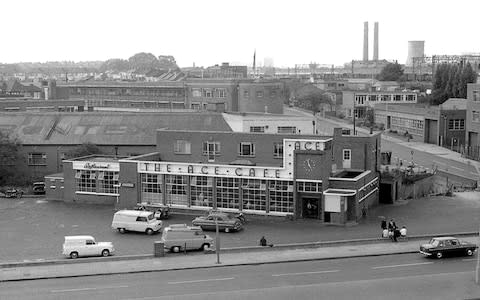Silverstone Classic 2018: vicious Grand Prix two-strokes from Japan and ‘ton-up’ British café racers

Motorcycle racing has been a part of Silverstone life ever since bored RAF pilots kick-started their own bikes into life and raced them around the perimeter road of the Wellington bomber base during the Second World War.
This July, squadrons of grand old motorcycles will return to the airbase-turned-racetrack for the superb Silverstone Classic historic motor racing event. In the vanguard will be a stunning collection of Grand Prix motorcycles, ridden by many of the same men who raced them at Silverstone when the Northamptonshire venue hosted the British Grand Prix during the Seventies and Eighties.
Some of the greatest heroes of that era – such as world champions Freddie Spencer, Wayne Gardner and Phil Read MBE – will take to the track on a pack of screaming two-stroke 500cc motorcycles, regarded as the most challenging race bikes of all time.
These machines – entered by the World GP Bike Legends organisation – were renowned for their vicious kick-in-the-backside power delivery, which kept hospitals busy wherever the Grand Prix circus went. Teak-tough Australian Gardner, who won the 1987 500cc world title for Honda, can’t even remember how many bones he broke during his Grand Prix career.
“Those bikes were nasty pieces of work,” recalls Gardner, whose eldest son Remy is following in his father’s Grand Prix wheel tracks. “They made a hell of a lot of horsepower, but it was all hidden at the top of the rev range. If you didn’t get the throttle just right, the thing would spin the rear tyre and spit you over the handlebars. You’d be flying through the air at 90 miles an hour before you knew what had happened. I got to know the doctors very well!”

American Spencer, the only man in history to win the senior 500cc and intermediate 250cc world titles in the same year, was renowned for his almost supernatural ability to master the peaky two-strokes, but even his stellar career was cut short by injury.
“You had to be on the top of your game to get the best out of those motorcycles,” he says. “They were very challenging, which made it a special time to be competing in the world championships.”
Gardner, Spencer, Read and other former greats will reacquaint themselves with these notorious bone-breakers – Honda’s NS500, Suzuki’s RGV500, Yamaha’s YZR500 and others – when they ride high-speed laps of the modern Silverstone circuit on Saturday July 21 and Sunday July 22.
And if you want to know exactly what these bikes were like to ride, you can ask the riders yourself during special meet-and-greet sessions organised throughout the weekend.
Those bikes were nasty pieces of work. They made a hell of a lot of horsepower, but it was all at the top of the rev range. If you didn’t get the throttle just right, the thing would spin the rear tyre and spit you over the handlebars. You’d be flying through the air at 90mph before you knew what had happened. I got to know the doctors very well
Wayne Gardner
Not far from the Silverstone Classic World GP Bike Legends paddock will be the good people of London’s legendary Ace Cafe, which celebrates its 80th anniversary this summer.
The Ace is as much a part of motorcycling culture as the derring-do of Grand Prix aces. Opened in 1938 to quench the thirst of truckers as they worked their way around the old North Circular Road in London, the Ace survived bombing during the war to become an infamous gathering place for bikers during the Fifties and Sixties.
This was the era of the “Ton-Up Boy”, when 100 miles an hour was about as fast as it got on a road bike. The Ace became a mecca for these speed-obsessed youngsters and their almost exclusively British motorcycles. At weekends the Ace car park was packed with the greatest creations of Britain’s world-famous motorcycle industry: BSAs, Nortons, Royal Enfields, Triumphs, Velocettes, Vincents and many more.

The owners of these fine machines wanted to prove their prowess – both as riders and engine tuners – so they organised impromptu races, which usually started and finished at the Ace.
Legend has it that each (highly illegal) race started when someone placed a 45rpm single on the Ace’s jukebox. The game was to race a mile or so up the road and then return to the Ace before the song had finished. Hence was born the cult of the café racers, which spawned a whole new breed of race-bred road bike, called, naturally enough, café racers.
The Ace Cafe celebrates its 80th birthday at the Silverstone Classic with an array of 80 very special motorcycles, many of them café racers and many of the products of the British industry, which was mostly based in the Midlands, not far from Silverstone.

Anyone with a classic motorcycle is welcome to become part of this year’s anniversary celebrations and should contact the Silverstone Classic organisers, or Ace Cafe direct, for more information on how to join in.
The combination of the Ace Cafe and World GP Bike Legends neatly brackets either end of motorcycling’s cultural rainbow, from brightly coloured one-piece racing leathers and full-face helmets emblazoned with corporate logos, to the de rigueur uniform of the dedicated café racer: open-face crash-hats, black leather jacket, oily blue jeans and black motorcycling boots.
They are both sights that you must not miss.
Mat Oxley is a columnist for Motor Sport. Founded in 1924, Motor Sport is the world’s oldest motor racing magazine
For tips and advice, visit our Advice section, or sign up to our newsletter here
More classic car stories at Telegraph Cars

 Yahoo News
Yahoo News 
